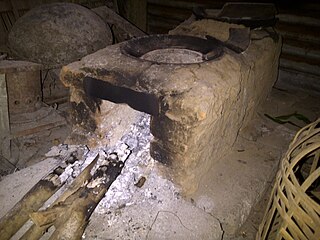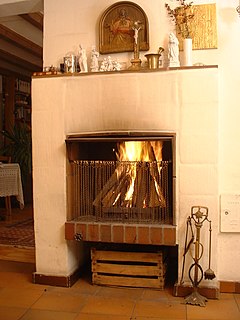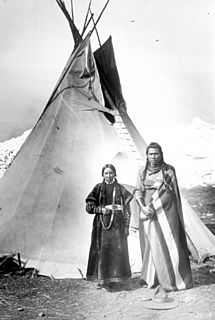
A tepee, also spelled teepee or less commonly tipi, and often called a lodge in older English writings, is a conical tent, traditionally made of animal skins upon wooden poles. Modern tepees usually have a canvas covering. A tepee is distinguished from other conical tents by the smoke flaps at the top of the structure.

A chimney is an architectural ventilation structure made of masonry, clay or metal that isolates hot toxic exhaust gases or smoke produced by a boiler, stove, furnace, incinerator or fireplace from human living areas. Chimneys are typically vertical, or as near as possible to vertical, to ensure that the gases flow smoothly, drawing air into the combustion in what is known as the stack, or chimney effect. The space inside a chimney is called the flue. Chimneys are adjacent to large industrial refineries, fossil fuel combustion facilities or part of buildings, steam locomotives and ships.

Kiowa people are a Native American tribe and an indigenous people of the Great Plains of the United States. They migrated southward from western Montana into the Rocky Mountains in Colorado in the 17th and 18th centuries, and finally into the Southern Plains by the early 19th century. In 1867, the Kiowa were moved to a reservation in southwestern Oklahoma.

A stove is a device that burns fuel or uses electricity to generate heat inside or on top of the apparatus. It has seen many developments over time and serves the main purpose of cooking food.

A kitchen hood, exhaust hood, or range hood is a device containing a mechanical fan that hangs above the stove or cooktop in the kitchen. It removes airborne grease, combustion products, fumes, smoke, heat, and steam from the air by evacuation of the air and filtration. In commercial kitchens exhaust hoods are often used in combination with fire suppression devices so that fumes from a grease fire are properly vented and the fire is put out quickly. Commercial vent hoods may also be combined with a fresh air fan that draws in exterior air, circulating it with the cooking fumes, which is then drawn out by the hood.

A fireplace or hearth is a structure made of brick, stone or metal designed to contain a fire. Fireplaces are used for the relaxing ambiance they create and for heating a room. Modern fireplaces vary in heat efficiency, depending on the design.

A wigwam, wickiup, wetu (Wampanoag), or wiigiwaam (Ojibwe) is a semi-permanent domed dwelling formerly used by certain Native American tribes and First Nations people and still used for ceremonial events. The term wickiup is generally used to refer to these kinds of dwellings in the Southwestern United States and Western United States, while wigwam is usually applied to these structures in the Northeastern United States as well as Ontario and Quebec in central Canada. The names can refer to many distinct types of Native American structures regardless of location or cultural group. The wigwam is not to be confused with the Native Plains teepee, which has a very different construction, structure, and use.

A chimenea, also spelled chiminea, is a freestanding front-loading fireplace or oven with a bulbous body and usually a vertical smoke vent or chimney.

A smokebox is one of the major basic parts of a steam locomotive exhaust system. Smoke and hot gases pass from the firebox through tubes where they pass heat to the surrounding water in the boiler. The smoke then enters the smokebox, and is exhausted to the atmosphere through the chimney. Early locomotives had no smokebox and relied on a long chimney to provide natural draught for the fire but smokeboxes were soon included in the design for two main reasons. Firstly and most importantly, the blast of exhaust steam from the cylinders, when directed upwards through an airtight smokebox with an appropriate design of exhaust nozzle, effectively draws hot gases through the boiler tubes and flues and, consequently, fresh combustion air into the firebox. Secondly, the smokebox provides a convenient collection point for ash and cinders ("char") drawn through the boiler tubes, which can be easily cleaned out at the end of a working day. Without a smokebox, all char must pass up the chimney or will collect in the tubes and flues themselves, gradually blocking them.

A flue is a duct, pipe, or opening in a chimney for conveying exhaust gases from a fireplace, furnace, water heater, boiler, or generator to the outdoors. Historically the term flue meant the chimney itself. In the United States, they are also known as vents for boilers and as breeching for water heaters and modern furnaces. They usually operate by buoyancy, also known as the stack effect, or the combustion products may be 'induced' via a blower. As combustion products contain carbon monoxide and other dangerous compounds, proper 'draft', and admission of replacement air is imperative. Building codes, and other standards, regulate their materials, design, and installation.

An earth lodge is a semi-subterranean building covered partially or completely with earth, best known from the Native American cultures of the Great Plains and Eastern Woodlands. Most earth lodges are circular in construction with a dome-like roof, often with a central or slightly offset smoke hole at the apex of the dome. Earth lodges are well-known from the more-sedentary tribes of the Plains such as the Hidatsa, Mandan, and Arikara, but they have also been identified archaeologically among sites of the Mississippian culture in the eastern United States.

A pellet stove is a stove that burns compressed wood or biomass pellets to create a source of heat for residential and sometimes industrial spaces. By steadily feeding fuel from a storage container (hopper) into a burn pot area, it produces a constant flame that requires little to no physical adjustments. Today's central heating systems operated with wood pellets as a renewable energy source can reach an efficiency factor of more than 90%.

Improved cook stoves (ICS) are biomass stoves that are intended to replace traditional cook stoves and open fires, in the context of energy poverty and cooking. As of 2020, more than 2.6 billion people in developing countries lack access to clean, modern fuel and technologies for cooking, and therefore rely on burning polluting fuels such as wood, animal dung, coal, or kerosene for cooking.

A rocket stove is an efficient and hot burning stove using small-diameter wood fuel. Fuel is burned in a simple combustion chamber containing an insulated vertical chimney, which ensures almost complete combustion prior to the flames reaching the cooking surface. Rocket stove designs are most often used for portable stoves for cooking but the design is also used for large fixed stoves in institutions, and to make rocket mass heaters for heating.

A masonry heater is a device for warming an interior space through radiant heating, by capturing the heat from periodic burning of fuel, and then radiating the heat at a fairly constant temperature for a long period. Masonry heaters covered in tile are called cocklestoves. The technology has existed in different forms, from back into the Neoglacial and Neolithic periods. Archaeological digs have revealed excavations of ancient inhabitants utilizing hot smoke from fires in their subterranean dwellings, to radiate into the living spaces. These early forms have evolved into modern systems.

A smoke hole is a hole in a roof for the smoke from a fire to vent. Before the invention of the smoke hood or chimney, dwellings had smoke holes to allow the smoke from the hearth to escape.

Household air pollution (HAP) is a significant form of indoor polluted air mostly relating to cooking and heating methods used in developing countries.
Tipi is a dwelling used by North American Indians of the Great Plains.

A wood-burning stove is a heating or cooking appliance capable of burning wood fuel and wood-derived biomass fuel, such as sawdust bricks. Generally the appliance consists of a solid metal closed firebox, often lined by fire brick, and one or more air controls. The first wood-burning stove was patented in Strasbourg in 1557, two centuries before the Industrial Revolution, which would make iron an inexpensive and common material, so such stoves were high end consumer items and only gradually spread in use.

The chimney is the part of a steam locomotive through which smoke leaves the boiler. Steam locomotive exhaust systems typically vent cylinder exhaust through the chimney to enhance draught through the boiler. Chimneys are designed to carry exhaust steam and smoke clear of the driver's line of sight while remaining short enough to clear overhead structures. Some chimneys included features to avoid dispersing sparks.

















